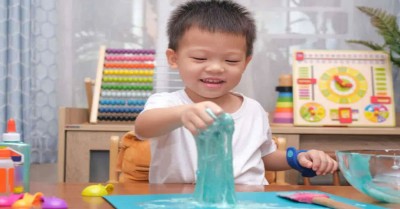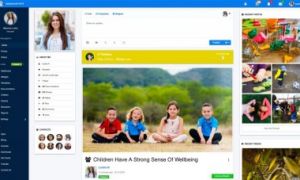Sensory Play is an early childhood educational approach that allows children to use all their senses when exploring their learning environment. The following article provides the benefits of sensory play and how you can incorporate it into the learning environment.
Helps Cognitive Development
The more children use all their senses early in their lives, the more their brains build neural pathways and synapses, leading to better cognitive skills in later life. A great way to engage all the senses in your young learners is through art. Invite the little ones to use colour and materials as they want. This might mean splashing, squelching, dribbling, and stamping with paint and glue rather than just scribbling with crayons. Also keep a variety of materials and textures like beads, yarn, clay, string, fabric, cardboard, and sponge within easy reach for them to pick and play with.
Exploring The Environment
One of the greatest benefits of sensory play is that it helps children to explore their natural environment and thereby reap all the rewards of being in the outdoors. Some of the ways you can use Nature for sensory learning are:
- Planning a sensory scavenger hunt in the woods that helps children notice varied sounds, movements, colours, smells and tastes.
- Setting about on a nature trail to explore textures like smooth, rough, grainy, dry, squishy, prickly and soft.
- Let older children deduce the difference between flowers with attractive colours and sweet smells and then explain the science behind it.
Supports Self-regulation
One of the best ways to regulate emotions is to anchor one’s senses to the here and now. And sensory play can be hugely useful in dialling down different forms of emotional arousal. Even something as mundane as playing with mud can be relaxing as some kids may find all that squishing and squelching oddly soothing.
On the other hand, if you are trying to get your learners excited about a task, activities like digging one’s fingers deep into bins of beans can be stimulating. However, keep in mind that the appeal of sensory experiences may be rather individualistic in nature; so what might be relaxing for a child – like having a go at the swing – might be stimulating for another.
So it is important to assess the children’s sensory needs first and then plan ways to include it in the learning environment. Yet another good idea is to include sensory breaks over the day so that after a period of focused activity, children can unwind with a choice of a favourite sensory activity.
Caters To Multiple Intelligences
For quite some time now, educators have realised the truth of multiple intelligences. While some kids be visual learners, others may use sound, touch, movement and even smells and tastes to learn. Sensory play with its appeal to multiple senses caters to different types of intelligence as well to children on the spectrum who have varied sensory needs.
Makes Learning Fun
Finally, sensory play is a great way to make learning an enjoyable experience. So if you are teaching sorting, use different coloured balls of play dough or if your lesson is on social greetings, have your learners role-play conversations with little action figures in a rice bin.
Further Reading
Benefits Of Sensory Play - The following are suggested learning objectives that support a child's overall development.
Sensory Processing Activities For Children To Increase Attention - The following article provides strategies and activity ideas for auditory, visual, tactile, oral, and movement sensory stimulation.
Sensory Bin Ideas For Toddlers and Preschoolers - The following article provides a list of sensory play items that can be included in a sensory bin for children to explore.
Reference:
Exploring the Benefits of Sensory Play for Children, Only About Children







 As an Educator in Australia, your pay rate falls under the Children’s Services Award 2010. This award states the minimum amount that an employer can
As an Educator in Australia, your pay rate falls under the Children’s Services Award 2010. This award states the minimum amount that an employer can When working as a qualified Early Childhood Teacher (with a university degree) within a service, your rate of pay will come from the Educational Services
When working as a qualified Early Childhood Teacher (with a university degree) within a service, your rate of pay will come from the Educational Services When working as a Diploma Qualified Educator your pay rate is from the Children's Services Award 2010. This Award states your minimum rate of pay
When working as a Diploma Qualified Educator your pay rate is from the Children's Services Award 2010. This Award states your minimum rate of pay When working as a Cert 3 Qualified Educator, your pay rate is from the Children's Services Award 2010. This Award states your minimum rate of
When working as a Cert 3 Qualified Educator, your pay rate is from the Children's Services Award 2010. This Award states your minimum rate of Educational Leaders play a crucial role in their early childhood service by ensuring that the educational program aligns with best practices and supports the holistic
Educational Leaders play a crucial role in their early childhood service by ensuring that the educational program aligns with best practices and supports the holistic In early childhood education and care, ratios are more than a technicality—they are a frontline safeguard. Every child deserves responsive supervision, emotional connection, and developmental
In early childhood education and care, ratios are more than a technicality—they are a frontline safeguard. Every child deserves responsive supervision, emotional connection, and developmental With the new national child safety reforms kicking in on 1 September 2025, early childhood services like yours have a real opportunity to lead the
With the new national child safety reforms kicking in on 1 September 2025, early childhood services like yours have a real opportunity to lead the Here’s a comprehensive Mobile Phone and Smart Watch Policy tailored for early childhood education and care (ECEC) services in Australia, aligned with the latest 2025
Here’s a comprehensive Mobile Phone and Smart Watch Policy tailored for early childhood education and care (ECEC) services in Australia, aligned with the latest 2025 The Sea of Fish Challenge is a national initiative that invites children, educators, families, and communities to create and display fish artworks as a symbol
The Sea of Fish Challenge is a national initiative that invites children, educators, families, and communities to create and display fish artworks as a symbol Across the early childhood education and care sector, educators are sounding the alarm: current staffing ratios are insufficient to deliver safe, meaningful, and developmentally appropriate
Across the early childhood education and care sector, educators are sounding the alarm: current staffing ratios are insufficient to deliver safe, meaningful, and developmentally appropriate


